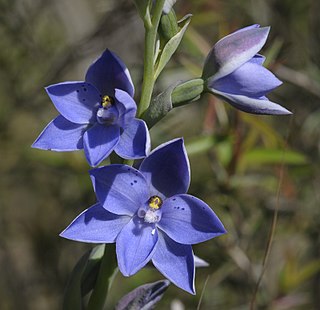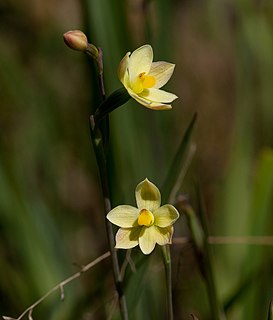
Thelymitra crinita, commonly known as the blue lady orchid, the queen orchid, the lily orchid, is a species of orchid which is endemic to the south-west of Western Australia. It has a single broad, oval leaf and up to fifteen brilliant blue flowers with a blue column with the lobe on top of the anther covered with short, finger-like calli.

Thelymitra macrophylla, commonly called the large-leafed sun orchid or scented sun orchid, is a species of flowering plant in the orchid family Orchidaceae, and is endemic to the south-west of Western Australia. It has a single thick, broad, leathery leaf and up to twenty five relatively large dark blue to purplish flowers with white, toothbrush-like tufts.

Thelymitra ixioides, known as the spotted sun orchid or dotted sun orchid, is a species of orchid that is native to southern and eastern Australia and to New Zealand. It has a single long, thin, dark green leaf and up to ten flowers which occur in a range of colours, most commonly blue to purple but usually with small, dark blue spots. It is a variable species, similar to T. juncifolia which has smaller flowers.

Thelymitra graminea, commonly called the shy sun orchid, is a species of orchid in the family Orchidaceae and is endemic to the south-west of Western Australia. It has a single leathery, channelled leaf and up to ten relatively small blue, self-pollinating flowers with white, toothbrush-like tufts on the top of the anther.

Thelymitra granitora, commonly called the coastal granite sun orchid or coastal sun orchid, is a species of orchid in the family Orchidaceae and is endemic to the south-west of Western Australia. It has a single short, curved and channelled dark green leaf and up to eight relatively large pale blue or white, self-pollinating flowers with white mop-like tufts on the top of the anther.
Thelymitra vulgaris, commonly called the slender sun orchid or common sun orchid, is a species of orchid in the family Orchidaceae and endemic to the south-west of Western Australia. It has a single erect, dark green leaf and up to nine relatively small, blue to purplish or white flowers.
Thelymitra xanthotricha, commonly called the yellow tufted sun orchid or yellow tufted slender sun orchid, is a species of orchid in the family Orchidaceae and endemic to the south-west of Western Australia. It has a single erect, fleshy, channelled, dark green leaf and up to six relatively large dark blue to purplish flowers.
Thelymitra hiemalis, commonly called the winter sun orchid, is a species of orchid that is endemic to Victoria. It is a winter flowering orchid with greenish sepals and blue or mauve petals with large, irregular, darker spots.

Thelymitra juncifolia, known as the large-spotted sun orchid, is a species of orchid that is endemic to south-eastern Australia and to New Zealand. It has a single thin, dark green leaf and up to five blue flowers with relatively large, dark blue spots on the dorsal sepal and petals. It is similar to T. ixioides but has fewer, smaller flowers with larger dark blue spots.
Thelymitra sparsa, commonly called the wispy sun orchid, is a species of orchid that is endemic to Tasmania. It has a single erect, fleshy leaf and up to six relatively small blue flowers with a few small darker spots. The flowers are self-pollinated and open only slowly on hot days. The species is restricted to a few restricted montane sites in south-eastern Tasmania.

Thelymitra canaliculata, commonly called the flushed sun orchid or blue sun orchid is a species of orchid in the family Orchidaceae and is endemic to the south-west of Western Australia. It has a single erect, fleshy leaf and up to twenty eight blue flowers with darker veins and sometimes flushed with pink. The lobe on top of the anther is blackish with a yellow crest.
Thelymitra latiloba, commonly called the wandoo sun orchid or wandoo shirt orchid, is a species of orchid in the family Orchidaceae and endemic to the south-west of Western Australia. It has a single erect, fleshy, channelled, dark green leaf and up to twelve blue flowers with darker blue veins and sometimes flushed with mauve. The lobe on top of the anther is wavy.
Thelymitra occidentalis, commonly called the western azure sun orchid or rimmed orchid, is a species of orchid in the family Orchidaceae and is endemic to the south-west of Australia. It has a single erect, fleshy, channelled, dark green leaf and up to fifteen blue flowers with darker blue veins and sometimes flushed with pink. The lobe on top of the anther has a wavy, yellow crest.
Thelymitra cornicina, commonly called the lilac sun orchid, is a species of orchid in the family Orchidaceae and is endemic to the south-west of Western Australia. It has a single narrow, pale green leaf and up to eight lilac-tinged blue flowers with the lobe on top of the anther covered with short, finger-like calli.

Thelymitra flexuosa, known as the twisted sun orchid, is a species of orchid that is endemic to southern Australia. It has a single thin, wiry leaf and up to four cream-coloured to canary yellow flowers with four rows of short hairs on the back of the column. It is a common and widespread species, superficially similar to T. antennifera.

Thelymitra sargentii, commonly called the freckled sun orchid, is a species of orchid in the family Orchidaceae and is endemic to Western Australia. It has a single thick, leathery leaf and up to twenty five strongly scented, lemon yellow flowers with brown blotches. It grows in arid areas but where it receives runoff during rainfall.

Thelymitra magnifica, commonly called the Crystal Brook sun orchid, is a species of orchid in the family Orchidaceae and is endemic to a small area in the south-west of Western Australia. It has a single erect, flat, leathery leaf and up to eight crowded, dark golden brown flowers with yellow streaks and blotches. The column has broad, deeply fringed, yellow or brownish wings.
Thelymitra uliginosa, commonly called southern curly locks or swamp curly locks, is a species of orchid in the family Orchidaceae and endemic to the south-west of Western Australia. It has a single erect leaf, spiralling around the flowering stem and a single small pink, mauve, blue or purplish flower with darker veins and sometimes darker blotches. There are two narrow, yellow arms on the sides of the column.

Thelymitra petrophila, commonly known as the granite sun orchid, is a species of orchid that is endemic to Western Australia. It has a single erect, channelled, long light green leaf and up to ten or more pale blue to mauve or pink flowers. It grows in drier area, usually in shallow soil pockets on granite outcrops.
Thelymitra paludosa, commonly known as the plain sun orchid, is a species of orchid that is endemic to Western Australia. It has a single erect, channelled, dark green leaf and up to ten or more blue to violet flowers. It grows in higher rainfall areas near the south coast.











